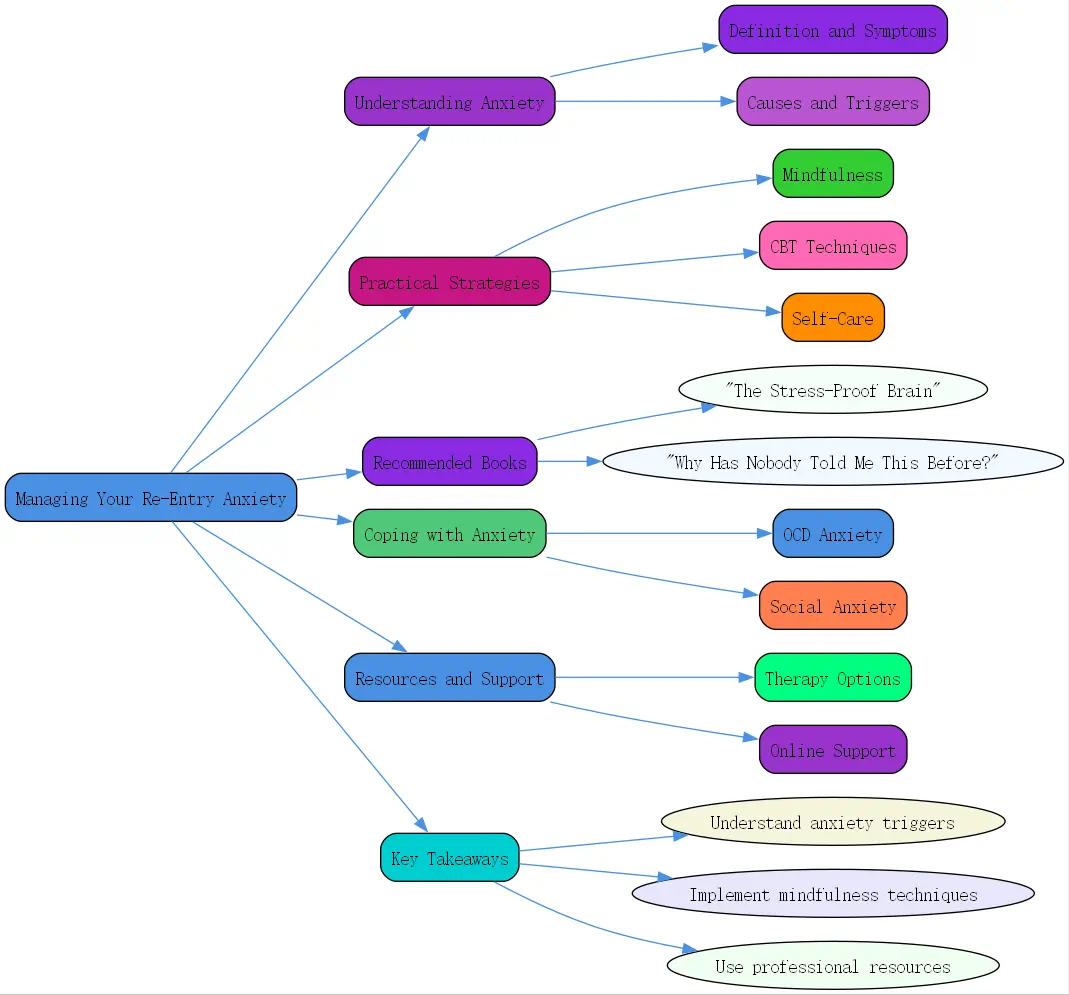As we navigate the complexities of returning to our pre-pandemic routines, many of us are experiencing a phenomenon known as re-entry anxiety. This guide, brought to you by BrainTalking, will explore the intricacies of managing your re-entry anxiety, offering expert insights, practical strategies, and valuable book recommendations to help you regain your confidence and peace of mind.
Understanding Re-Entry Anxiety

Re-entry anxiety is a form of stress and worry that occurs as we transition back to our normal activities after a period of isolation or significant change. It’s characterized by feelings of unease, apprehension, and even fear about resuming social interactions, returning to work, or engaging in activities we once considered routine.
Definition and Symptoms of Re-Entry Anxiety
Re-entry anxiety manifests in various ways, both physically and emotionally. Common symptoms include:
- Increased heart rate and sweating when thinking about social situations
- Difficulty sleeping or concentrating
- Persistent worry about health and safety
- Feeling overwhelmed by the prospect of returning to “”normal”” life
- Avoidance of social gatherings or public spaces
These symptoms can range from mild to severe, impacting daily functioning and overall well-being.
Common Causes and Triggers
Several factors contribute to re-entry anxiety:
- Uncertainty about health risks and safety measures
- Changes in social norms and expectations
- Fear of losing the comfort and security of home routines
- Concerns about work-life balance and productivity
- Anxiety about appearance or social skills after prolonged isolation
Understanding these triggers is crucial in developing effective coping strategies.
Differentiating Re-Entry Anxiety from Other Forms of Anxiety
While re-entry anxiety shares similarities with other anxiety disorders, it has unique characteristics:
- It’s specifically tied to the transition from isolation to social reintegration
- It may be temporary, subsiding as individuals adjust to new routines
- It often involves a mix of health anxiety and social anxiety
Recognizing these distinctions can help in tailoring appropriate management techniques.
Practical Strategies for Managing Anxiety
Managing your re-entry anxiety requires a multifaceted approach. BrainTalking recommends incorporating various techniques to build a robust anxiety management toolkit.
Mindfulness and Meditation Techniques
Mindfulness practices can significantly reduce anxiety by grounding you in the present moment:
- Start with short, guided meditations focusing on breath awareness
- Practice body scans to release physical tension
- Use mindful walking to connect with your surroundings
Consistency is key; aim for daily practice, even if it’s just for a few minutes.
Cognitive Behavioral Therapy (CBT) Techniques
CBT is a powerful tool for managing anxiety:
- Identify and challenge negative thought patterns
- Use thought records to track and analyze anxious thoughts
- Practice reframing techniques to develop more balanced perspectives
Consider working with a therapist to learn and apply these techniques effectively.
The Role of Self-Compassion and Self-Care
Self-compassion is crucial when managing re-entry anxiety:
- Treat yourself with kindness and understanding
- Acknowledge that your feelings are valid and shared by many
- Prioritize self-care activities that nurture your physical and emotional well-being
Remember, it’s okay to take things at your own pace and set boundaries as needed.
Exposure Therapy
Gradual exposure can help you build confidence in social situations:
- Start with low-stress activities, like short outings to familiar places
- Gradually increase the duration and complexity of social interactions
- Use relaxation techniques to manage anxiety during exposures

Work with a mental health professional to create a personalized exposure plan.
Recommended Books for Managing Anxiety
Literature can be a powerful tool in managing your re-entry anxiety. Here are some highly recommended books:
1. “”The Stress-Proof Brain”” by Melanie Greenberg: Offers neuroscience-based strategies for rewiring your brain’s response to stress.
2. “”Why Has Nobody Told Me This Before?”” by Dr. Julie Smith: Provides practical advice for various mental health challenges, including anxiety.
3. “”Mindfulness for Stress Management”” by Robert Shaker: Presents 50 simple mindfulness practices to reduce stress and cultivate calmness.
4. “”Burnout: The Secret to Unlocking the Stress Cycle”” by Emily Nagowski and Amelia Nagowski: Explores burnout in women and offers strategies for completing the stress cycle.
5. “”Hardcore Self-Help”” by Robert Duff: A no-nonsense guide to understanding and managing anxiety with humor and honesty.
These books offer diverse perspectives and techniques, allowing you to find approaches that resonate with your unique experiences and needs.
Coping with Specific Anxiety Types
Different forms of anxiety may require tailored strategies. Here’s how to address some common types:
Managing OCD Anxiety
Obsessive-Compulsive Disorder (OCD) can be particularly challenging during times of transition:
- Practice exposure and response prevention (ERP) techniques
- Use mindfulness to observe obsessive thoughts without engaging with them
- Consider medication in consultation with a psychiatrist
Strategies for Separation Anxiety
Separation anxiety may intensify as we return to work or school:
- Establish consistent routines to provide a sense of security
- Use gradual separation techniques to build confidence
- Practice self-soothing strategies for moments of distress

Addressing Social Anxiety
Social anxiety can be exacerbated by prolonged isolation:
- Start with small, manageable social interactions
- Use cognitive restructuring to challenge negative social beliefs
- Practice relaxation techniques before and during social events
Remember, progress may be gradual, and setbacks are a normal part of the process.
Additional Resources and Support
Managing your re-entry anxiety doesn’t have to be a solitary journey. BrainTalking recommends exploring various support options:
Therapy and Counseling Options
Professional help can be invaluable:

- Consider individual therapy with a licensed mental health professional
- Explore group therapy options for shared experiences and support
- Look into teletherapy services for convenient, remote access to care
Online Support Groups and Communities
Connect with others facing similar challenges:
- Join anxiety-focused forums and discussion groups
- Participate in virtual support meetings
- Engage with mental health communities on social media platforms
Other Helpful Resources
Utilize digital tools to supplement your anxiety management:
- Try anxiety-tracking apps to monitor symptoms and triggers
- Explore guided meditation apps for on-the-go relaxation
- Access reputable mental health websites for ongoing education and support
By combining these strategies, resources, and support systems, you can effectively manage your re-entry anxiety and navigate the transition with greater confidence and ease.
Q&A Section
Q: How long does re-entry anxiety typically last?
A: The duration of re-entry anxiety can vary significantly from person to person. For some, it may last a few weeks as they adjust to new routines and social interactions. For others, it could persist for several months, especially if underlying anxiety disorders are present. The key is to be patient with yourself and consistently apply anxiety management techniques. If symptoms persist or worsen over time, it’s important to seek professional help. Remember, recovery is not always linear, and it’s normal to have good days and challenging days. With the right support and strategies, most people find that their re-entry anxiety gradually diminishes as they become more comfortable with their new normal.
Key Takeaways
- Understand the nature of re-entry anxiety and its common triggers
- Implement mindfulness, CBT, and exposure techniques for anxiety management
- Explore recommended books for in-depth strategies and insights
- Address specific anxiety types with tailored approaches
- Utilize professional support, online communities, and digital resources
- Be patient and compassionate with yourself throughout the process
- Remember that BrainTalking is here to support you on your journey to managing your re-entry anxiety




